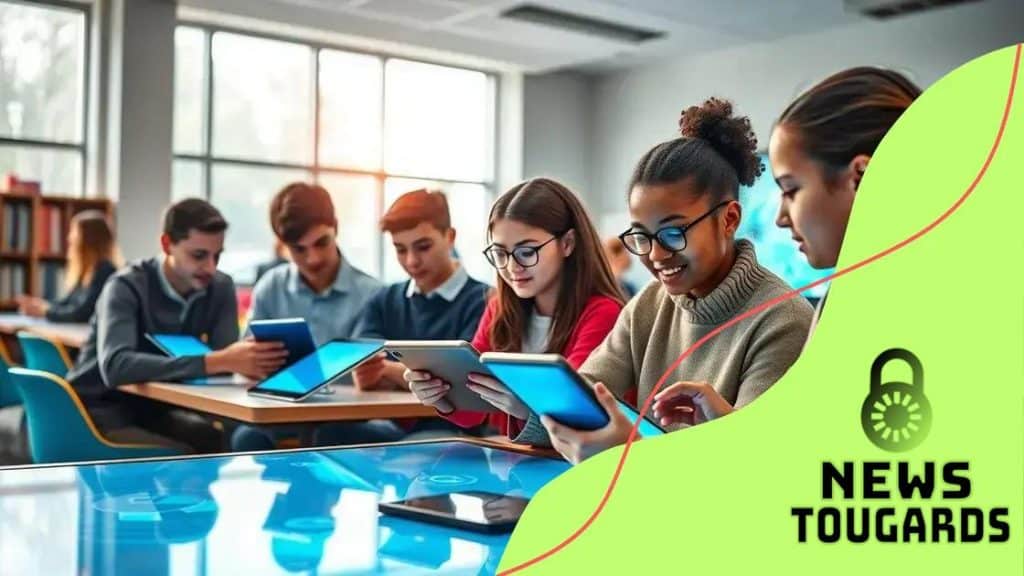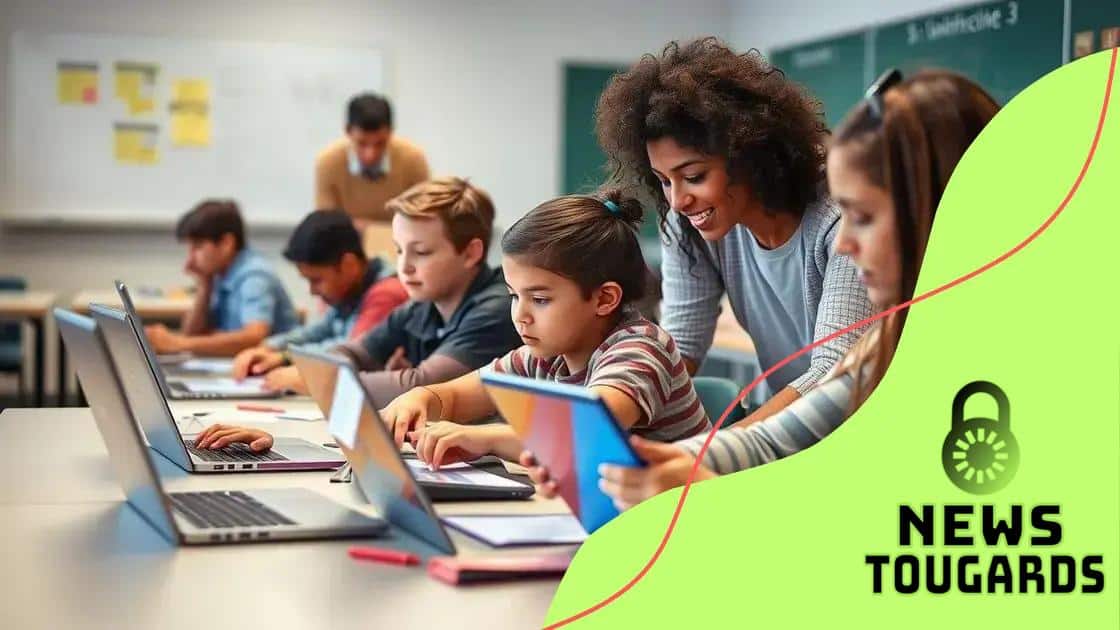The rise of edtech startups and their impact on education

The rise of edtech startups is revolutionizing education by providing personalized learning experiences, enhancing student engagement, and facilitating global collaboration through innovative technology.
The rise of edtech startups is changing the educational landscape. These innovative companies are reshaping how students learn and teachers instruct. Have you noticed how tech is enhancing classrooms?
Understanding edtech startups
Understanding edtech startups is essential to grasp how they are reshaping education. These companies utilize technology to enhance learning experiences and improve educational outcomes. They often bridge gaps between traditional methods and modern needs, providing solutions that engage students and facilitate learning in innovative ways.
One of the main advantages of edtech startups is their ability to personalize education. Technology allows for tailored learning experiences that meet individual student needs. In this context, students can learn at their own pace, ensuring they fully grasp the material.
Key Features of Edtech Startups
Edtech startups typically focus on several critical features:
- Accessibility: They make learning available to all students, regardless of location.
- Interactivity: Many platforms use multimedia content to engage learners.
- Data-Driven Insights: Startups often analyze student performance to improve educational strategies.
- Collaboration Tools: They provide tools that foster teamwork and communication among students.
The impact of these features can be profound. For instance, students using interactive tools might find subjects like math or science more engaging. Through quizzes, video content, and gamified learning, students often feel more motivated.
Moreover, edtech startups frequently address specific needs. Some focus on language learning, while others might specialize in skills training for careers. This variety ensures that there is something for every learner.
Challenges and Considerations
Despite their benefits, understanding the challenges edtech startups face is crucial. These can include issues related to funding, competition, and the need for constant innovation. Additionally, educational institutions may be slow to adopt new technologies, posing barriers to growth.
Nonetheless, the future looks promising for edtech. As technology continues to evolve, so will these startups. They will likely play a significant role in shaping how future generations learn, making education more inclusive and effective.
Key innovations shaping education
Many key innovations are shaping education today, making learning more engaging and effective. These advancements help students connect with the material in meaningful ways. For instance, online learning platforms have become popular, allowing students to access courses from anywhere.
Personalized Learning
One important innovation is personalized learning. This approach tailors education to fit individual student needs, enabling them to learn at their own speed.
- Adaptive learning technology: Adjusts content based on student performance.
- Learning analytics: Provides insights into student progress, helping teachers plan interventions.
- Gamification: Uses game-like elements to motivate students.
- Online resources: Offers supplementary materials to enhance understanding.
Another significant trend is the incorporation of technology in everyday classroom activities. Devices like tablets and smart boards engage students by making lessons more interactive. For example, students can collaborate on projects in real-time, allowing for a deeper understanding of subjects.
Virtual and Augmented Reality
The use of virtual and augmented reality is revolutionizing how students experience learning. Instead of reading about a historical event, students can immerse themselves in a virtual simulation. This approach makes lessons exciting and memorable.
Additionally, blended learning combines traditional teaching methods with online elements. This mix allows students to enjoy face-to-face interaction while benefiting from online resources. In doing so, teachers enhance their teaching methods, making learning more flexible.
Finally, the rise of mobile learning has made education accessible for everyone. Students can now learn using their smartphones or tablets, anytime and anywhere. This flexibility empowers learners to manage their education on their terms, contributing to their motivation and success.
How edtech improves student outcomes

Understanding how edtech improves student outcomes is crucial in today’s educational landscape. Technology has transformed learning environments, offering diverse tools that help students succeed. More than just adding digital resources, edtech optimizes how educators teach and students learn.
Enhanced Engagement
One way edtech enhances student outcomes is by increasing engagement. Learning platforms often incorporate videos, quizzes, and interactive activities. These elements help teachers capture student interest and stimulate participation.
- Interactive lessons: Technology allows for dynamic lessons that adjust to students’ needs.
- Real-time feedback: Many platforms provide instant results, helping students understand their progress.
- Gamification: Game-like elements make learning fun and encourage collaboration.
- Accessible content: Educational resources can be accessed anytime, making studying convenient.
Another noteworthy improvement comes from personalized learning. With the help of data analytics, educators can tailor lessons to fit individual student needs. For example, students struggling with a concept can receive additional resources specifically designed for them, ensuring no one falls behind.
Data-Driven Insights
Data not only helps in personalization, but it also provides insights into student performance across a class. Teachers can analyze data trends to understand which teaching methods are most effective. This understanding allows educators to adapt their strategies and meet the diverse needs of their students.
Moreover, access to online resources expands the opportunities for students. They can explore subjects outside of the classroom, enhancing their knowledge and promoting a love for learning. This kind of self-directed learning empowers students to take charge of their education.
Finally, the support from parents and communities is enhanced through edtech tools. Many platforms enable parents to monitor their children’s progress directly. This transparency fosters communication between educators and families, creating a supportive learning environment for students.
Challenges faced by edtech companies
Edtech companies face numerous challenges as they seek to revolutionize education. While they offer innovative solutions, navigating the educational landscape can be difficult. Understanding these challenges is essential for their growth and effectiveness.
Market Competition
One major challenge is the intense competition in the edtech market. With many startups emerging, standing out becomes crucial. Each company strives to offer unique features that attract schools and students.
- Brand recognition: New entrants must establish their brands to gain trust.
- Innovation pace: Keeping up with technological advancements requires constant innovation.
- Customer loyalty: High competition makes retaining users a challenge.
- Funding access: Securing investment can be difficult for emerging startups.
This competition can lead to a race for lower prices, which often affects the quality of service. Providers must balance cost efficiency with maintaining high educational standards.
Adoption Barriers
The adoption of new technologies poses another significant challenge. Many schools are slow to integrate edtech solutions into their teaching methods. Educators must be convinced of the benefits before making a switch.
Factors influencing adoption include the training provided to teachers, compatibility with existing systems, and ongoing support. If teachers do not feel confident using the tools, their effectiveness diminishes. Additionally, some schools may lack the necessary infrastructure, such as reliable internet access, to implement these tools effectively.
Moreover, establishing partnerships with educational institutions can be time-consuming. Building relationships with schools requires patience and persistence, often delaying product implementation.
Regulatory Hurdles
Edtech companies must also navigate complex regulations. Compliance with educational standards and data privacy laws can be a daunting task. As schools prioritize student safety, edtech solutions must ensure they protect sensitive information.
This regulatory landscape often varies by region, further complicating the business for companies aiming to expand. Adapting products to meet these requirements may require additional resources and time.
Despite these challenges, many edtech companies continue to innovate and find ways to succeed in a competitive environment. Success often hinges on their ability to adapt to the evolving educational landscape while keeping costs manageable.
The future of education with edtech
The future of education with edtech is bright and full of possibilities. As technology continues to advance rapidly, education will adapt to meet the needs of 21st-century learners. Innovations in this field promise to create more engaging, effective, and personalized learning experiences.
Personalized Learning Experiences
One key aspect of the future is the rise of personalized learning experiences. Educational technologies leverage data to customize lessons based on each student’s abilities and interests. This approach helps students grasp concepts at their own pace.
- Tailored content: Resources can adjust to the learning level of each student.
- Flexible learning paths: Students can choose their own educational trajectories.
- Immediate feedback: Instant assessments allow for quicker understanding of gaps.
- Increased student agency: Learners take more control over their educational process.
This personalized approach boosts engagement and encourages students to take charge of their learning, leading to better outcomes.
Collaborative Learning Environments
Another exciting development is the potential for enhanced collaborative learning environments. Edtech tools can connect students across schools or even countries, fostering a global classroom experience. With collaborative software, students can work on group projects seamlessly, regardless of location.
This expansion encourages teamwork and allows students to understand diverse perspectives. Teachers can facilitate these interactions, preparing students for the global workforce.
Integration of Emerging Technologies
The integration of emerging technologies will also play a significant role in shaping the future of education. Using artificial intelligence and virtual reality, educators can create immersive learning experiences. For example, virtual reality can transport students to historical events or complex scientific environments.
These technologies make learning more engaging and can deepen understanding by providing experiential learning opportunities. As technology becomes more accessible, its application in classrooms is likely to grow significantly.
Overall, the future of education with edtech will likely focus on creating a more inclusive learning environment. As schools embrace these tools, barriers will diminish, making quality education available to students worldwide. With continuous innovation in technology, the potential for transformation in education is limitless.
FAQ – Frequently Asked Questions about the Future of Education with Edtech
How does edtech personalize learning experiences?
Edtech uses data analytics to tailor lessons based on each student’s needs, allowing them to learn at their own pace.
What role does technology play in student collaboration?
Technology connects students around the world, enabling them to work together on projects and share diverse perspectives.
Can emerging technologies enhance the learning process?
Yes, technologies like AI and VR provide immersive experiences that help students understand complex concepts better.
How does edtech make education more accessible?
Edtech tools break down geographical and financial barriers, making quality education available to more students globally.





